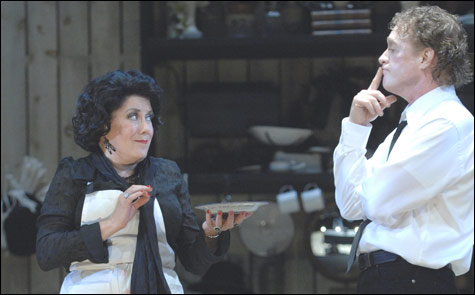
SWEENEY TODD: Stylized and strip-searched, Sondheim’s glittering bit of Grand Guignol displays the furious nihilism at its core. |
The evil is boiled down in the revival of SWEENEY TODD, THE DEMON BARBER OF FLEET STREET bubbling away at the Colonial Theatre (through November 4), and that makes for a stew far tastier than Mrs. Lovett’s human-hamburger pies. It’s no less tough, though. Set around a wooden coffin and featuring 10 singers/actors who are also the orchestra, British director John Doyle’s stripped-down reinvention of the 1979 Stephen Sondheim masterpiece about a maniacally enraged barber and the floozy entrepreneur who turns his homicides into pasties is as ghoulish as it is ingenious.
Staged as if it were a madman’s fantasy (or the events that turned him into a madman), the new Sweeney Todd was hatched at a small theater in England, where the overlay of cast and band was an economic as well as a creative brainstorm. It went on to the West End and then Broadway, where it won 2006 Tony Awards for Doyle’s direction as well as for Sarah Travis’s pared-down orchestrations. It should have won a third for sheer virtuosity — imagine being able to scrape all the rage and poignancy from the tabloid story, wrap your tonsils around the ravishing score, and canoodle away on one or more instruments. In some cases, it becomes difficult to unstring the characters from their musical apparatus. For all the show’s warbling about “innocent” Johanna, I may never again think of the demon barber’s lost daughter without a cello between her legs and throwing her stranger-stirred sexuality into agitated bow work.

Stylized and strip-searched, Sondheim’s glittering bit of Grand Guignol (with a slim, corrosive libretto by Hugh Wheeler) displays the furious nihilism at its core. It’s not just the vengeful barber but the world that’s mad — and that’s scarier than buckets o’ blood, though we get those, too, signaling, along with red light and a piercing whistle, each throat cutting. This is a procedure as grim as any slasher movie, if purposefully less realistic, and so is the rest of the staging, which is set before some looming shelves of junk on which David Hess’s frighteningly depressive Sweeney climbs. Trying to lighten him up is Tony winner Judy Kaye’s cheerfully amoral Mrs. Lovett, whose waggling butt is encased in a tight black mini above torn fishnets and whose mezzo is a whole lot richer than those pies. But the real star of the proceedings is Doyle, the middle-aged toiler in the vineyards of British theater brought to international attention by this riveting reduction. If you baked him into a pie, he’d be cold-bloodedly delicious — and probably cut his way through the crust from the inside.
Something wicked also this way comes in MACBETH, which is being given an all-female production by Actors’ Shakespeare Project (at BU College of Fine Arts’ Studio 102 through November 11) that underlines the gender differences with regard to power and potency in Shakespeare’s play — and calls attention to how many references there are in it to manliness. The other emphasis in Adrianne Krstansky’s illuminating production is the supernatural: amid much thunder and portent, it’s the witches — grotesquely female and as unstoppable as childbirth — who run this show.
At first thought, Macbeth seems an odd candidate for a same-sex production, unless you want to turn the power couple at its center into a couple of mediæval Scottish lesbians. After all, Lady Macbeth pushes her husband to the murder that will start his downward spiral into paranoia and tyranny by impugning his manhood and implicitly threatening to pull a Lysistrata. Marya Lowry, a black-clad soldier sporting a mane of blond hair, and Paula Plum, cinched into a stiff bit of feminine armor over clingy red velour, do not sexualize the Macbeths: their partnership is intimate and intense but more boardroom than boudoir. But the production, a collaboration between Krstansky and the cast, introduces a primal female connection between the witches and Lady Macbeth, who wakes screaming from a nightmare that would appear to have been their initial, orgiastic huddle. In Plum’s provocative reading, Lady M., though a sneeringly tough cookie who cows the servants, has a bit of the irrepressible hysteric in her from the get-go. Add internalized guilt and terror at how Duncan’s murder has unhinged her husband and a furious hand-washing craziness is not far away. Lowry’s authoritative if sullen Macbeth, on the other hand, reacts to guilt with increasingly irrational aggression. Just like a guy — though, once his back is to the wall, an exceptionally bad one.
In terms of gender exploration, the standout is Jacqui Parker, a hard-edged if family-friendly, very military Banquo. Bobbie Steinbach, clad in a white suit and shakily maneuvering a cane, is an avuncular Big Daddy of a Duncan and makes fine comic relief of the Porter, as well as holding up her third of those sexual and shimmering rag-bag witches. Sarah Newhouse pulls off the trick of presenting a flinty Macduff and his brutally murdered wife. And newcomer Robin JaVonne Smith proves a sincere, well-spoken Malcolm. The haunted, haunting production is abetted by Susan Zeeman Rogers’s set design, which features kitchen knives as if hung by Rachel Ray, and by David Wilson’s sound design, which is full of thunder, seaside cawing, and even a fractured lullaby to set off the play’s theme of fathers and sons.